Mysterious signals from 'hell planet' 40 light-years from Earth could finally be solved by James Webb Space Telescope
The hellish super-Earth '55 Cancri e' may be constantly losing and re-growing its atmosphere, a new study of the planet's strange transit signals suggests.

The first super-Earth astronomers ever discovered has given off strange signals for nearly two decades, and scientists may have finally figured out why.
Volcanoes on this hellish world periodically open up and spew hot gas that forms an atmosphere, only for that atmosphere to burn off and leave the planet bald again, a new study suggests. Testing that theory will involve training the James Webb Space Telescope (JWST) on the strange exoplanet.
The planet, 55 Cancri e, is a rocky world about eight times as massive as our planet and was discovered in 2004 around 40 light-years from Earth.
Related: 35 jaw-dropping images from the James Webb Space Telescope
The planet is so close to its parent star, at less than 2% of the distance between Earth and the sun, that it makes a complete orbit in just 17 hours. This sets up some rather extreme conditions on the planet that have defied explanation.
Perhaps the most puzzling aspect of the planet, as pointed out in a paper accepted in September to the Astrophysical Journal Letters, is the nature of its transit signal. This is the light visible from Earth when 55 Cancri e crosses across the face of its parent star, making a tiny eclipse, and the light visible when the planet passes behind its star.
Sometimes, when 55 Cancri e passes behind its star, no visible light comes from the planet itself, while other times the planet emits a strong visible light signal. In infrared light, there's always a signal, though that signal varies in strength.
Get the world’s most fascinating discoveries delivered straight to your inbox.
Observations of that infrared light with the Spitzer Space Telescope indicated that the day side of the planet experienced exceptionally scorching temperatures of well over 4,400 degrees Fahrenheit (2,427 degrees Celsius), while the night side had cooler, but still hellish, temperatures of around 2,060 F (1127 C).
In the new study, the authors hypothesize that the planet's proximity to its star is causing it to outgas, meaning that giant volcanoes and thermal vents open up, spewing hot carbon-rich elements into the atmosphere. But the planet can't hold on to that atmosphere for long due to the extreme heat, and this gas eventually gets blown away, leaving the planet bare until the outgassing begins again.
Unlike most planets, the atmosphere of 55 Cancri e is unstable. The outgassing process tries to bulk up the atmosphere, while the extreme radiation and solar wind from the star blow it away. But these two processes are not in balance, leading to the situation where sometimes the planet has an atmosphere, and other times it doesn't.
The researchers believe this imbalance in the planetary atmosphere can explain the strange transit signals. When the planet is in its atmosphere-less "bald" phase, no visible light comes from the planet's atmosphere, because there isn't one, but the planet's hot surface still emits infrared light. When the atmosphere puffs up, both the visible light and all the radiation coming from the surface show up in the transit signal.
While this is just a hypothesis, JWST offers a way to test it. By measuring the pressure and temperature of the planet's atmosphere, scientists could determine whether an atmosphere is always present.

Paul M. Sutter is a research professor in astrophysics at SUNY Stony Brook University and the Flatiron Institute in New York City. He regularly appears on TV and podcasts, including "Ask a Spaceman." He is the author of two books, "Your Place in the Universe" and "How to Die in Space," and is a regular contributor to Space.com, Live Science, and more. Paul received his PhD in Physics from the University of Illinois at Urbana-Champaign in 2011, and spent three years at the Paris Institute of Astrophysics, followed by a research fellowship in Trieste, Italy.


